Running a Welder on a Generator
Running a welder on a generator can be a game-changer for welders working in remote locations or those who need a portable power source. However, choosing the right generator and understanding how to match it with your welder’s requirements is crucial for safety and efficiency. In this guide, we’ll walk through everything you need to know to successfully run a welder on a generator, from power calculations to safety precautions.
Understanding Power Requirements
How Welders Consume Power
Welders require a specific amount of power to operate efficiently, measured in amps, volts, and watts. Here’s how they relate:
- Amps (A): The current flowing through the welder
- Volts (V): The electrical pressure required
- Watts (W): Total power consumed (Watts = Volts × Amps)
Single-Phase vs. Three-Phase Welders
- Single-phase welders: Common for home and light industrial use, typically run on 120V or 240V.
- Three-phase welders: Used in heavy industrial applications, requiring more stable and powerful electricity sources.
Duty Cycle and Power Needs
The duty cycle is the percentage of time a welder can operate before needing a cooldown. A 60% duty cycle at 200A means it can weld for 6 minutes before needing a 4-minute rest. Generators must support these power fluctuations without overloading.
Choosing the Right Generator
Matching Generator Wattage with Welder Requirements
You must choose a generator that supplies enough power for your welder’s peak demand.
| Welder Type | Amp Rating | Voltage | Required Generator Size |
|---|---|---|---|
| Stick Welder (140A) | 30A | 240V | 7200W |
| MIG Welder (180A) | 35A | 240V | 8400W |
| TIG Welder (200A) | 40A | 240V | 9600W |
| Plasma Cutter (50A) | 50A | 120V | 6000W |
Generator Types: Inverter vs. Conventional
- Inverter Generators: Provide stable, clean power, ideal for sensitive electronics in modern welders.
- Conventional Generators: Produce raw AC power, often leading to fluctuations that can damage electronic components.
Fuel Type Options
- Gasoline: Common and affordable but burns quickly.
- Diesel: More fuel-efficient and durable but costs more initially.
- Propane: Cleaner-burning and ideal for long-term use.
How to Calculate Generator Size
Use this formula to determine the required generator wattage:
Watt = Voltage X Amps X Duty Cycle Factor
Example Calculation: For a 200A welder operating at 240V with a 60% duty cycle: 200A X 240W = 48,000W
Applying a 60% duty cycle: This means a generator with at least 28,800W peak power is recommended.
Setting Up a Welder with a Generator
Connecting the Welder Properly
- Always use a generator with clean, stable power output to prevent damage.
- Ensure the welder’s power input matches the generator’s output.
Using Extension Cords: Do’s and Don’ts
- Use heavy-duty cords rated for high amperage.
- Avoid long extension cords, as voltage drop can cause inefficiencies.
Ensuring Proper Grounding for Safety
- Attach a proper ground rod to avoid electrical shocks.
- Check for secure connections before starting.
Common Problems & Troubleshooting
Generator Overload Issues
- If the generator shuts down, it might be overloaded—upgrade to a larger unit.
- Reduce welder power settings to match generator capacity.
Voltage Fluctuations & How to Handle Them
- Use an inverter generator or a power stabilizer.
- Keep fuel levels consistent to avoid fluctuations.
Preventing Overheating
- Run the generator in a well-ventilated area.
- Allow the welder to cool down between high-power usage.
Safety Precautions
- Wear protective gear (gloves, helmet, fire-resistant clothing).
- Keep fuel stored away from the welding area.
- Ensure ventilation to avoid carbon monoxide poisoning.
Pros and Cons of Using a Generator
Advantages
Portable and allows welding in remote locations.
Works as an emergency power source.
Versatile fuel options.
Disadvantages
Higher fuel costs.
Noisy operation.
Can be heavy and bulky.
Maintenance Tips
- Regularly change oil and filters to keep the generator running efficiently.
- Check and clean spark plugs to maintain a strong ignition.
- Run the generator monthly to prevent fuel system clogging.
- Inspect cords and connections for wear and tear.
FAQs
Can I run a MIG welder on a generator?
Yes, but ensure the generator meets the welder’s power requirements and provides stable voltage.
What size generator do I need for a 200A welder?
A generator with at least 28,000W peak power is recommended for a 200A welder.
Can a generator damage my welder?
Yes, if it produces unstable power. Using an inverter generator reduces the risk.
Why does my generator struggle to run my welder?
Your generator may be undersized, or voltage fluctuations may be causing inefficiencies.
What’s the best generator for welding in remote locations?
A diesel or propane-powered inverter generator is ideal for long-term remote welding due to efficiency and reliability.
Conclusion
Running a welder on a generator is a fantastic solution for mobile and remote welding, but it requires careful planning. Choosing the right generator size, maintaining proper connections, and following safety guidelines are essential to ensure smooth operation. With the right setup, you can weld efficiently and safely, even in the most challenging environments.
 Welding of Welders All about Welding and Welders
Welding of Welders All about Welding and Welders




